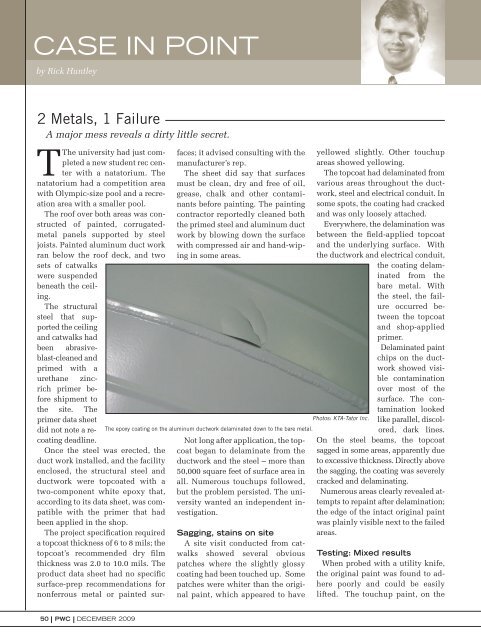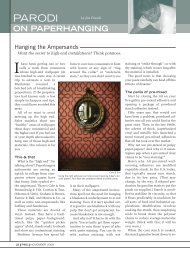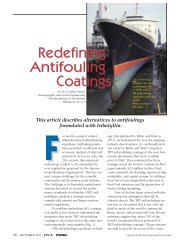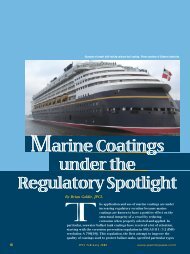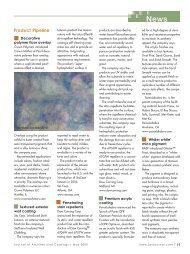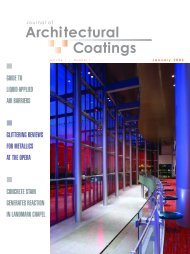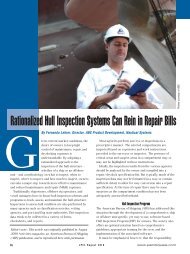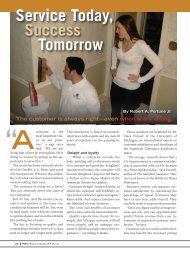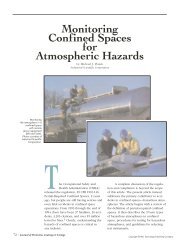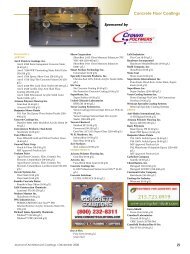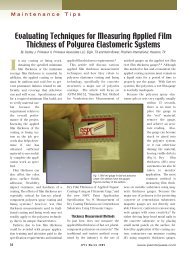CASE IN POINT - PaintSquare
CASE IN POINT - PaintSquare
CASE IN POINT - PaintSquare
- No tags were found...
You also want an ePaper? Increase the reach of your titles
YUMPU automatically turns print PDFs into web optimized ePapers that Google loves.
<strong>CASE</strong> <strong>IN</strong> PO<strong>IN</strong>Tby Rick Huntley2 Metals, 1 FailureA major mess reveals a dirty little secret.TThe university had just completeda new student rec centerwith a natatorium. Thenatatorium had a competition areawith Olympic-size pool and a recreationarea with a smaller pool.The roof over both areas was constructedof painted, corrugatedmetalpanels supported by steeljoists. Painted aluminum duct workran below the roof deck, and twosets of catwalkswere suspendedbeneath the ceiling.The structuralsteel that supportedthe ceilingand catwalks hadbeen abrasiveblast-cleanedandprimed with aurethane zincrichprimer beforeshipment tothe site. Theprimer data sheetdid not note a recoatingdeadline.Once the steel was erected, theduct work installed, and the facilityenclosed, the structural steel andductwork were topcoated with atwo-component white epoxy that,according to its data sheet, was compatiblewith the primer that hadbeen applied in the shop.The project specification requireda topcoat thickness of 6 to 8 mils; thetopcoat’s recommended dry filmthickness was 2.0 to 10.0 mils. Theproduct data sheet had no specificsurface-prep recommendations fornonferrous metal or painted sur-faces; it advised consulting with themanufacturer’s rep.The sheet did say that surfacesmust be clean, dry and free of oil,grease, chalk and other contaminantsbefore painting. The paintingcontractor reportedly cleaned boththe primed steel and aluminum ductwork by blowing down the surfacewith compressed air and hand-wipingin some areas.Photos: KTA-Tator Inc.The epoxy coating on the aluminum ductwork delaminated down to the bare metal.Not long after application, the topcoatbegan to delaminate from theductwork and the steel – more than50,000 square feet of surface area inall. Numerous touchups followed,but the problem persisted. The universitywanted an independent investigation.Sagging, stains on siteA site visit conducted from catwalksshowed several obviouspatches where the slightly glossycoating had been touched up. Somepatches were whiter than the originalpaint, which appeared to haveyellowed slightly. Other touchupareas showed yellowing.The topcoat had delaminated fromvarious areas throughout the ductwork,steel and electrical conduit. Insome spots, the coating had crackedand was only loosely attached.Everywhere, the delamination wasbetween the field-applied topcoatand the underlying surface. Withthe ductwork and electrical conduit,the coating delaminatedfrom thebare metal. Withthe steel, the failureoccurred betweenthe topcoatand shop-appliedprimer.Delaminated paintchips on the ductworkshowed visiblecontaminationover most of thesurface. The contaminationlookedlike parallel, discolored,dark lines.On the steel beams, the topcoatsagged in some areas, apparently dueto excessive thickness. Directly abovethe sagging, the coating was severelycracked and delaminating.Numerous areas clearly revealed attemptsto repaint after delamination;the edge of the intact original paintwas plainly visible next to the failedareas.Testing: Mixed resultsWhen probed with a utility knife,the original paint was found to adherepoorly and could be easilylifted. The touchup paint, on the50 PWC DECEMBER 2009
other hand, adheredfairly well and couldnot be easily removed.When measured inaccordance withASTM D 3359,Method A, “MeasuringAdhesion by TapeTest,” the topcoat adhesionwas found tovary considerably:very poor next toareas of spontaneousdelamination andvariable elsewhere.Coating sampleswere then removedfor microscopic examinationand infraredspectroscopic analysis.Microscopic analysis revealed asingle coat on most of the samples,with a wide-ranging thickness of 4.6to 25+ mils. The backs of samplesfrom areas of poor adhesion showedextensive visible contaminants,most slightly imbedded in the coating.Infrared spectroscopy analysis confirmedthat the topcoat was the epoxycoating specified for theproject.Dirty workIn the end, the field investigationand lab work clearlypointed to inadequate cleaning beforecoating as the main cause of thedelamination on both the ductworkand the steel.The problem was clearly evidenton the ductwork, where dark contaminationcovered much of theback of the white coating chips.Where the ductwork coating remainedintact, less contaminationwas visible and adhesion was muchbetter.Analysis showed only one layer of coating, but the thickness varied from 4.6 to 25+ mils.Satisfactory adhesion of a coatingon aluminum depends on propersurface cleaning. Aluminum ductworkis relatively smooth and is usuallycovered with protective oil. Theoil itself is a surface contaminantthat also attracts other contaminants.For a coating to adhere properly tothe smooth aluminum, it must be inclose contact with the surface. Anycontaminant creates a barrier andThe backs of the failed paint chipsshowed widespread contamination.acts as a bond breaker.Short cuts, lengthy woesThe methods used to remove thecontaminants from the ductwork—blowing with compressed air andwiping with a rag—were clearly inadequate.Dust on ductwork is oftenimbedded in oil, and compressed airwill not remove it. Wiping with arag usually just spreads the contaminantsaround.Proper methods of removing sur-face oils includewiping with a solvent-soakedrag orcleaning with a detergentsolution. Itwas obvious that neithermethod wasused here.The failure of thesteel coating also appearedto be causedby painting over acontaminated surface.The steel wasreportedly not topcoateduntil 12 to 16months after theshop-applied primer.With many primers,this delay alone could cause delamination.However, because theprimer’s data sheet indicated no topcoatingdeadline, the delay shouldnot have created a problem.The more likely culprit was thesteel’s exposure to dirt and othercontaminants during transportationand storage. As with the ductwork,the contamination impedes adhesionand acts as a bond breaker.Because the busy natatoriumcould not beclosed for repair, the coatingfailure still has notbeen completely repaired,and paint continues to flakeand peel. Complete repair will requireremoving the entire topcoat byhigh-pressure washing or scraping,thoroughly cleaning the bare surface,and reapplying the entireepoxy coating system.Rick Huntley (rhuntley@kta.com)is manager of consulting services forKTA-Tator Inc., which provides coatingsand construction consultingand inspection services worldwide.WWW.PA<strong>IN</strong>TSTORE.COM PWC 51


